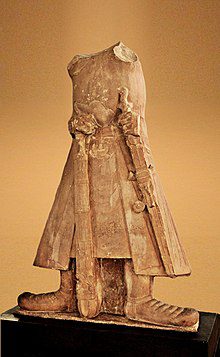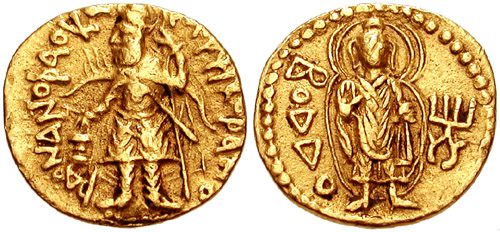Ancient Indian history is filled with stories of great monarchs. From the rise of the Mauryan empire Indian History has witnessed some of the greatest monarchs of all time.
The names of famous rulers like Gautamiputra Satakarni, Ashoka, Samudragupta, etc are taken with huge respect because of their immense contribution to their respective empires.
These visionary and audacious monarchs led to the rise of the Indian sub-continent in the fields of art, culture, architecture, and literature.
Similarly, there was another great monarch in ancient India whose empire extended from central Asia to the Malwa region of India.
This king was a great patron of art, and literature and was religiously tolerant too. His name was Kanishk (Kanishka) of the mighty Kushan Empire. He is considered the greatest of all the Kushanas kings as it was during his reign that this great empire reached its zenith.
Content
Background: Origin of the Kushanas
Historians suggest that the Kushanas were originally the branch of the Yueh-chi tribe of Central Asia. Several Chinese sources also confirm this fact.
From central Asia, this Yueh-chi tribe migrated south towards Bactria after suffering defeat from neighboring tribes. Later this tribe came into conflict with the Sakas in which the former got the upper hand.

Furthermore, after occupying the Bactrian region the Yueh-chi tribe established their capital in the Bokhara region. They gradually subjugated Gandhara and even expelled the Greeks and Parthians from here.
Their first known king is called Kujula Kadphises. He is responsible for the unification of the five tribes of Yueh-chi which was responsible for the foundation of the Kushan Empire.
Later Kadphisis’s son who is known as Vima Kadphises extended the empire’s boundary towards the Punjab region. It was during his reign that the Kushans reached Mathura.
Vima Kadhphises was succeeded by his able son Kanishka.
Rise of Devputra Kanishka
This king is considered the greatest of all the Kushan kings.
Note: It is believed that Kanishka stretched the boundaries of the mighty Kushans to Bihar in the east to Khorasan in the west, and from Khotan in the north to the Konkan in the south.
Some inscriptions also confirm that Kanishka controls the region of modern-day Uttar Pradesh, Punjab, and the northern region of Sindh.
His reign, however, is doubted by historians but the majority of historians had concluded that Kanishka might have ascended the throne in 78 CE and ruled till 101-103 CE. Furthermore, the discovery of the Kushan coins from Bengal and Orissa also suggests that the king surely had a great influence in these regions.
Note: Kanisha also adopted the title of Devputra
Both Chinese and Tibetan sources had confirmed the victorious campaign of Kanishka at Patliputra. In fact, the conquests of emperor Kanishka are divided into two phases by some historians.
In the early stages, the Kushans under Kanishk focused on subjugating the Ganga Valley. It was in this stage when the Kushan took the region situated east of Mathura. According to the famous Rabatak inscription, the Kushan king took Patliputra and Shri Champa (the eastern region of Bihar).
In the second stage, the emperor is believed to lead an expedition to Kashmir and central Asia. Rajatarangini which was written by Kalhana also mentions that the Kushan king had conquered the region of Kashmir. Later the famous Chinese traveler Hiuen Tsang also confirmed that Kanishka controlled the region of Gandhara and even established a capital at Peshawar.

In his last years, Kanisha had led an expedition the far north against the Chinese. However, this campaign was not successful.
Apart from the military campaigns of Kanishka, the Kushan king was also a great patron of art and culture. Notable authors like Hiuen Tsang and Alberuni suggested that the Kushan king built a huge monastery in his capital i.e. Peshawar.

This monastery which was built by Kanishka was the center of Buddhist culture. He also convoked the fourth Buddhist council in Kashmir.
Under Kanishka, the empire flourished in the fields of literature, scientific philosophy, and art. Some of the famous scholars of the Kanishka reign were
Charaka: Known as the father of Ayurveda
Ashvagosha: Author of Buddhacharita (Sacred biography of Buddha)
Nagarjuna: Known as Indian Einstein who gave the theory of relativity in the form of a Sutra
Agesilaus: Eminent Greek engineer.
In Kashmir, he also founded cities like Hushkapura, Jushkapura, and Kanishapura. He also inscribed the Greek, Sumerian, Persian and Indian deity on his coins. The patronization of famous schools of art like Gandhara and Mathura by Kanishka gives us glimpses of his tolerance towards every religion.
Furthermore, to rule efficiently the Kushan king placed several governors in major cities. Some of them were Mathura, UND, Varanasi, Manikyala, and Kshatrap.
His empire was not limited to one religion, Kanisha’s empire was a multi-religion empire. During his time the Kushans were able to control the important Silk Route in Central Asia. Furthermore, he also started the famous Saka Era which presently serves as the calendar of the Indian government.
However, it is also true that despite being so successful in his entire reign the name of this great king had vanished from our school’s textbooks. The emperor who carved out one of the strongest empires of its time failed to get any recognition from our country’s historians.
Want to know more about ancient India’s great monarchs
Read the Story of Skanda Gupta Vikramaditya
Donate to our Cause
If you support what we are doing and would like to contribute to help us grow and reach more Indians to teach them more about such forgotten historic Indian Heroes and stories, please consider donating any amount. It will help us grow

